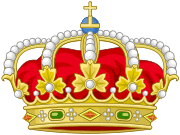El Escorial
The Royal Site of San Lorenzo de El Escorial (Spanish: Monasterio y Sitio de El Escorial en Madrid), commonly known as Monasterio del Escorial (Spanish pronunciation: [el eskoˈɾjal]), is a historical residence of the King of Spain, in the town of San Lorenzo de El Escorial, about 45 kilometres (28 miles) northwest of the Spanish capital, Madrid. It is one of the Spanish royal sites and functions as a monastery, basilica, royal palace, pantheon, library, museum, university, school and hospital. It is situated 2.06 km (1.28 mi) up the valley (4.1 km [2.5 mi] road distance) from the town of El Escorial.
| Royal Site of San Lorenzo de El Escorial | |
|---|---|
 A distant view of the Royal Seat of San Lorenzo de El Escorial | |
| Location | San Lorenzo de El Escorial, Spain |
| Coordinates | 40°35′20″N 4°08′52″W |
| Architect | Juan Bautista de Toledo |
| Governing body | Ministry of the Presidency |
| Official name: Monastery and Site of the Escorial, Madrid | |
| Type | Cultural |
| Criteria | i, ii, iv |
| Designated | 1984 (8th session) |
| Reference no. | 318 |
| State Party | |
| Region | Europe and North America |
| Official name: Monasterio de San Lorenzo | |
| Type | Real property |
| Criteria | Monument |
| Designated | 3 June 1931 |
| Reference no. | (R.I.) - 51 - 0001064 - 00000 |
 Location of Royal Site of San Lorenzo de El Escorial in Community of Madrid | |
El Escorial comprises two architectural complexes of great historical and cultural significance: the royal monastery itself and La Granjilla de La Fresneda, a royal hunting lodge and monastic retreat about five kilometres away. These sites have a dual nature; that is to say, during the 16th and 17th centuries, they were places in which the power of the Spanish monarchy and the ecclesiastical predominance of the Roman Catholic religion in Spain found a common architectural manifestation.[1] El Escorial was, at once, a monastery and a Spanish royal palace. Originally a property of the Hieronymite monks, it has become a monastery of the Order of Saint Augustine. It was also a boarding school (Real Colegio de Alfonso XII).[2]
Philip II of Spain (who reigned 1556–1598) engaged the Spanish architect Juan Bautista de Toledo to be his collaborator in the renovation and expansion of the complex at El Escorial. Juan Bautista had spent the greater part of his career in Rome, where he had worked on the basilica of St. Peter's, and in Naples, where he had served the king's viceroy, whose recommendation brought him to the king's attention. Philip appointed him architect-royal in 1559, and together they designed El Escorial as a monument to Spain's role as a center of the Christian world.[3]
On 2 November 1984, UNESCO declared The Royal Seat of San Lorenzo of El Escorial a World Heritage Site. It is a popular tourist attraction, often visited by day-trippers from Madrid – more than 500,000 visitors come to El Escorial every year.
Design and conception




El Escorial is situated at the foot of Mt. Abantos in the Sierra de Guadarrama. This austere location, hardly an obvious choice for the site of a royal palace, was chosen by King Philip II of Spain, and it was he who ordained the building of a grand edifice here to commemorate the 1557 Spanish victory at the Battle of St. Quentin in Picardy against Henry II, king of France.[4] He also intended the complex to serve as a necropolis for the interment of the remains of his parents, Charles I and Isabella of Portugal, himself, and his descendants.[4] In addition, Philip envisioned El Escorial as a center for studies in aid of the Counter-Reformation cause.
The building's cornerstone was laid on 23 April 1563. The design and construction were overseen by Juan Bautista de Toledo, who did not live to see the completion of the project. With Toledo's death in 1567, direction passed to his apprentice, Juan de Herrera, under whom the building was completed in 1584, in less than 21 years. To this day, la obra de El Escorial ("the work of El Escorial") is a proverbial expression for a thing that takes a long time to finish.[5]
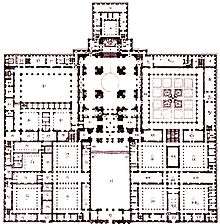
Since then, El Escorial has been the burial site for most of the Spanish kings of the last five centuries, Bourbons as well as Habsburgs. The Royal Pantheon contains the tombs of the Holy Roman Emperor Charles V (who ruled Spain as King Charles I), Philip II, Philip III, Philip IV, Charles II, Louis I, Charles III, Charles IV, Ferdinand VII, Isabella II, Alfonso XII, and Alfonso XIII. Two Bourbon kings, Philip V (who reigned from 1700 to 1724) and Ferdinand VI (1746–1759), as well as King Amadeus (1870–1873), are not buried in the monastery.
The floor plan of the building is in the form of a gridiron. The traditional belief is that this design was chosen in honor of St. Lawrence, who, in the third century AD, was martyred by being roasted to death on a grill. St. Lawrence’s feast day is 10 August, the same date as the 1557 Battle of St. Quentin.[4]
However, the origin of the building's layout is quite controversial. The grill-like shape, which did not fully emerge until Herrera eliminated from the original conception the six interior towers of the facade, was, by no means, unique to El Escorial. Other buildings had been constructed with interior courtyards fronting on churches or chapels; King's College, Cambridge, dating from 1441, is one such example; the old Ospedale Maggiore, Milan's first hospital, begun in 1456 by Antonio Filarete, is another grid-like building with interior courtyards. In fact, palaces of this approximate design were commonplace in the Byzantine and Arab world. Strikingly similar to El Escorial is the layout of the Alcázar of Seville and the design of the Alhambra at Granada where, as at El Escorial, two courtyards in succession separate the main portal of the complex from a fully enclosed place of worship.
Nonetheless, the most persuasive theory for the origin of the floor plan is that it is based on descriptions of the Temple of Solomon by the Judeo-Roman historian, Flavius Josephus: a portico followed by a courtyard open to the sky, followed by a second portico and a second courtyard, all flanked by arcades and enclosed passageways, leading to the "holy of holies". Statues of David and Solomon on either side of the entrance to the basilica of El Escorial lend further weight to the theory that this is the true origin of the design. A more personal connection can be drawn between the David-warrior figure, representing Charles V, and his son, the stolid and solomonically prudent Philip II. Echoing the same theme, a fresco in the center of El Escorial's library, a reminder of Solomon’s legendary wisdom, affirms Philip's preoccupation with the great Jewish king, his thoughtful and logical character, and his extraordinary monumental temple.[6]

The Temple-of-Solomon design, if indeed it was the basis for El Escorial, was extensively modified to accommodate the additional functions and purposes Philip II intended the building to serve. Beyond being a monastery, El Escorial is also a pantheon, a basilica, a convent, a school, a library, and a royal palace. All these functional demands resulted in a doubling of the building's size from the time of its original conception.
Built primarily from locally quarried gray granite, square and sparsely ornamented, El Escorial is austere, even forbidding, in its outward appearance, seemingly more like a fortress than a monastery or palace. It takes the form of a gigantic quadrangle, approximately 224 m by 153 m, which encloses a series of intersecting passageways and courtyards and chambers. At each of the four corners is a square tower surmounted by a spire, and, near the center of the complex (and taller than the rest) rise the pointed belfries and round dome of the basilica. Philip's instructions to Toledo were simple and clear, directing that the architects should produce "simplicity in the construction, severity in the whole, nobility without arrogance, majesty without ostentation."[7]
Aside from its explicit purposes, the complex is also an enormous storehouse of art. It displays masterworks by Titian, Tintoretto, Benvenuto Cellini, El Greco, Velázquez, Rogier van der Weyden, Paolo Veronese, Alonso Cano, José de Ribera, Claudio Coello and others.[8] The library contains thousands of priceless manuscripts; for example, the collection of the sultan, Zidan Abu Maali, who ruled Morocco from 1603 to 1627, is housed at El Escorial. Giambattista Castello designed the magnificent main staircase.
Sections of the building
In order to describe the parts of the great building in a coherent fashion, it may be useful to undertake an imaginary walking tour, beginning with the main entrance at the center of the western facade:
Courtyard of the Kings
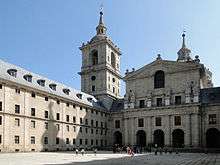
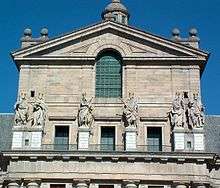
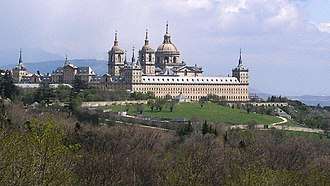
The first thing one finds upon arriving to El Escorial is the main façade. This has three doors: the middle one leads to the Courtyard of the Kings (Patio de los Reyes) and the side ones lead to a school and the other to a monastery. On the façade there is a niche where the image of a saint has been placed. The courtyard is an enclosure that owes its name to the statues of the Kings of Judah that adorn the façade of the Basílica, located at the back, from which one can access from the courtyard. This spectacular basilica has a floor in the shape of a Greek cross and an enormous cupola inspired by St. Peter's Basilica in Rome. The naves are covered with canyon vaults decorated with frescoes by Luca Giordano. The large chapel is one of the highlights in the basilica, presided by steps of red marble. Its main altarpiece is 30 meters high and divided in compartments of different sizes where are find bronze sculptures and canvas authored by Tibaldi, Zuccari or Leoni. In the Capitulary and the Sacristy Rooms, painting such as Joseph's Coat by Velázquez, The Last Supper by Titian, or The Adoration of the Sacred Host by Charles II by Claudio Coello are on exhibit.
Under the royal chapel of the Basilica is the Royal Pantheon. This is the place of burial for the kings of Spain. It is an octagonal Baroque mausoleum made of marble where all of the Spanish monarchs since Charles I have been buried, with the exception of Philip V, Ferdinand VI, and Amadeus of Savoy. The remains of Juan de Borbon, father of King Juan Carlos I of Spain, also rest in this pantheon despite the fact that he never became king himself. The enclosure is presided over by an altar of veined marble, and the sarcophagi are bronze and marble. also find the Pantheon of the Princes, where the bodies of the queens who did not have a crowned succession and the princes and princesses were laid to rest. This part was built in the nineteenth century.
After the basilica is the Courtyard of the Evangelists. This is a gardened patio in whose center rises a magnificent pavilion by Juan de Herrera in which one can find sculptures of the Evangelists. Around the courtyard are the galleries of the main cloister, decorated with frescoes by Pellegrino Tibaldi and his workshop, in which scenes from the history of the Redemption are represented. In the East gallery, one finds the splendid main staircase with a fresco-decorated vaulted ceiling depicting The glory of the Spanish monarchy painted by Luca Giordano in 1692.
.jpg)
Next is the Palace of the Austrians (Palacio de los Austrias), also known as the House of the King (Casa del Rey), which is found behind the presbytery of the basilica. The outbuildings of this palace are distributed around the Courtyard of the Fountainheads (patio de los Mascarones), of Italian style. Inside the House of the King are the Sala de las Batallas (Hall of Battles), which contains frescoes of the battles of San Quintín and Higueruela, among others. The next building contains the rooms of Philip II and of the Infanta Isabel Clara Eugenia. Another outbuilding is that of Alcoba del Rey, housing the bed in which Philip II died.
Basilica
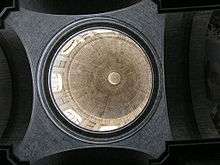
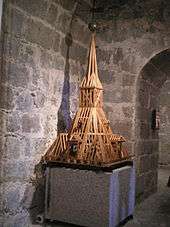
The basilica of San Lorenzo el Real, the central building in the El Escorial complex, was originally designed, like most of the late Gothic cathedrals of western Europe, to take the form of a Latin cross.[9] As such, it has a long nave on the west-east axis intersected by a pair of shorter transepts, one to the north and one directly opposite, to the south, about three-quarters of the way between the west entrance and the high altar. This plan was modified by Juan de Herrera to that of a Greek cross, a form with all four arms of equal length. Coincident with this shift in approach, the bell towers at the western end of the church were somewhat reduced in size and the small half-dome intended to stand over the altar was replaced with a full circular dome over the center of the church, where the four arms of the Greek cross meet.
Clearly Juan Bautista de Toledo's experience with the dome of St. Peter's basilica in Rome influenced the design of the dome of San Lorenzo el Real at El Escorial. However, the Roman dome is supported by ranks of tapered Corinthian columns, with their extravagant capitals of acanthus leaves and their elaborately fluted shafts, while the dome at El Escorial, soaring nearly one hundred metres into the air, is supported by four heavy granite piers connected by simple Romanesque arches and decorated by simple Doric pilasters, plain, solid, and largely unprepossessing. It would not be a flight of fancy to interpret St. Peter's as the quintessential expression of Baroque sensuality and the basilica at El Escorial as a statement of the stark rigidity and grim purposefulness of the Inquisition, the two sides of the Counter-Reformation.
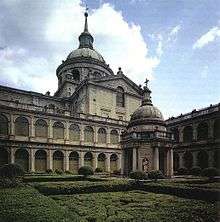
.jpg)
The most highly decorated part of the church is the area surrounding the high altar. Behind the altar is a three-tiered reredos, or altar screen, made of red granite and jasper, nearly twenty-eight metres tall, adorned with gilded bronze statuary by Leone Leoni, and three sets of religious paintings commissioned by Philip II. To either side are gilded life-size bronzes of the kneeling family groups of Charles and Philip, also by Leoni with help from his son Pompeo. In a shallow niche at the center of the lowest level is the tabernacle, a repository for the physical elements of the communion ceremony, a so-called "House of the Sacrament", designed by Juan de Herrera in jasper and bronze. It was built between 1579 and 1586 by Jacopo da Trezzo.
To decorate the reredos, the king's preferences were Michelangelo or Titian, but both of these giants were already more than eighty years old and in frail health.[10] Consequently, Philip consulted his foreign ambassadors for recommendations, and the result was a lengthy parade of the lesser European artists of that time, all swanning through the construction site at El Escorial seeking the king's favor.
One chapel exhibits the famous Crucifix carved in white marble by Benvenuto Cellini. This statue of Christ is unusual because it was represented fully nude; although for modesty reasons wears one cloth covering the genitals .
Palace of Philip II
Situated next to the main altar of the Basilica, the residence of King Philip II is made up of a series of austerely decorated rooms. It features a window from which the king could observe mass from his bed when incapacitated by the gout that afflicted him.
Hall of Battles
Fresco paintings here depict the most important Spanish military victories. These include a medieval victory over the Moors, as well as several of Philip's campaigns against the French.
Royal burial vaults
Pantheon of the Kings

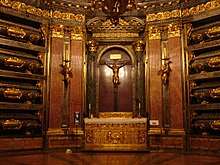
This chamber consists of twenty-six marble sepulchres containing the remains of the kings and queens regnant (the only queen regnant since Philip II being Isabella II), of the Habsburg and Bourbon dynasties from Charles I to the present, except for Philip V and Ferdinand VI.
The sepulchres also contain the remains of royal consorts who were parents of monarchs. The only king consort is Francis of Asis de Bourbon, husband of Queen Isabella II and father of Alphonse XII.
The most recent monarch interred in the pantheon is King Alphonse XIII, removed there from the Church of Santa Maria in Monserrato, Rome in 1980. The remains of Alphonse XIII's wife, Victoria Eugenie of Battenberg were interred in the pantheon in 2011.
The remains of Alphonse XIII's third son Juan, Count of Barcelona and daughter-in-law Maria de las Mercedes (the father and mother of the former king Juan Carlos I), lie at a prepared place called a pudridero, or decaying chamber, awaiting interment in the Pantheon of the Kings. With the interment of these remains, all the sepulchres in the pantheon will be filled. No decision has yet been announced as to the final resting place of now-abdicated Juan Carlos, Queen Sofía, Felipe VI, Queen Letizia, and any future monarchs and consorts.
There are two pudrideros at El Escorial, one for the Pantheon of the Kings and the other for the Pantheon of the Princes. These can only be visited by monks from the Monastery. In these rooms, the remains of the deceased are placed in a small leaden urn, which in turn will be placed in the marble sepulchres of the appropriate pantheon after the passage of fifty years, the estimated time necessary for the complete decomposition of the bodies.
The interment of the remains of Queen Victoria Eugenie and the Count and Countess of Barcelona in the Royal Pantheon will each constitute an exception to tradition. First, Victoria Eugenie, although the wife of a king, was never the mother of a king in the strict sense. Secondly, the Count of Barcelona never reigned as king, although he was head of the Spanish Royal Family between the renunciation of his father's rights on 14 January 1941 and his renunciation of his own rights in favour of his son, Juan Carlos I on 14 May 1977. Thirdly, the Countess of Barcelona was the mother of a king but not the wife of a king. However, some consider the Count of Barcelona to have been de jure King of Spain from 1941 - 1977, which in turn would make him, his mother, Queen Victoria Eugenie and his wife, the Countess of Barcelona eligible for interment in the Pantheon of Kings.
There has already been one exception to tradition: Elisabeth of Bourbon is for the moment the only queen in the pantheon who has not been mother to a king. That is because her only son, the presumed heir to the throne, died after her but before he could become king. But she is the great grandmother of Philip V (by her daughter Maria Theresa of Spain) and she is the ancestor of the current king of Spain.
The walls of polished Toledo marble are ornamented in gold-plated bronze.
All of the wood used in El Escorial comes from the ancient forests of Sagua La Grande, on the so-called Golden Coast of Cuba.
Pantheon of the Princes
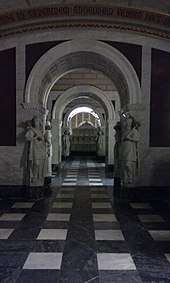
Completed in 1888, this group of nine burial chapels is the final resting place of princes, princesses and consorts other than the parents of monarchs. With floors and ceiling of white marble, the tomb of Prince John of Austria is especially notable.
Among the more recent interments is that of Infante Alphonse in October 1992. The younger brother of King Juan Carlos I, he was buried originally in Portugal, after being killed in a still-mysterious 1956 shooting at the family home in Estoril.
In 1994, King Juan Carlos I signed a decree raising his cousin and close personal friend Carlos, Duke of Calabria to the status of a Spanish infante, making him eligible for interment in the Pantheon of the Princes. Upon his death in October 2015, his funeral was held at El Escorial and his body placed in the pudridero, awaiting future interment in the pantheon.

Currently, thirty-seven of the sixty available niches are filled.
Art gallery
Consists of works of the German, Flemish, Venetian, Lombard, Ligurian and more Italian and Spanish schools from the fifteenth, sixteenth and seventeenth centuries.
Architectural museum
Its eleven rooms showcase the tools, cranes and other materials used in the construction of the edifice, as well as reproductions of blueprints and documents related to the project.
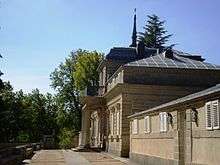
Gardens of the Friars
Constructed at the order of Philip II, a great lover of nature, these constitute an ideal place for repose and meditation. Manuel Azaña, who studied in the monastery's Augustinian-run school, mentions them in his Memorias (Memoirs) and his play El jardín de los frailes (The Garden of the Friars). Students at the school still use it today to study and pass the time.
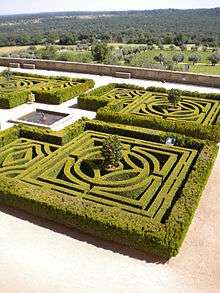
Library
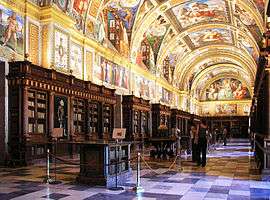
The Escorial has three libraries inside, not just one. One is located behind the Chorus of the basilica. Another, within the monastery itself, used to be distributed in the different cells and rooms of the monks and that the Augustine monks have gradually managed to turn into their own. Finally, the Royal one, which is public in everything, from its design to its special bull of protection.[11] From the beginning, the Royal Library was meant to be a monumental work of art, and its execution was commissioned to the most prominent architects of the moment: Juan de Toledo and Juan de Herrera. It constituted, along with the basilica, the heart of the entire project and the whole exterior and distribution of the project was redrafted several times to accommodate changes in the organization of the library itself. As it was usual for Juan de Herrera's work, it was the most advanced of its kind in Europe. It was the first library on the continent that broke with medieval design. Domenico Fontana was inspired by, if not copied, Herrera's design after a visit and used it for the Vatican's Library.[11] The Library, like everything else in El Escorial, forms part of a larger symbolic structure and has symbolic meaning functioning within it. It links the convent and the seminary on the principle axis of the building, symbolizing the union of the spiritual and physical world. The books of the most "profane" subjects, such as History, Geography or Botanics, are located in the part closest to the entrance, and as the corridors advance towards the basilica the subjects turn into more abstract forms of themselves like Poetry, Grammar or Mathematics. The corridors of the library branch out in different sections just to re-converge in the end. The subjects closest to the basilica are those the King conceived as being the most abstract distillation of the others, and the closest to the origin, which was God in the Basilica: theology, geometry, and mathematics. The visitor must leave the noisy world behind and walk through the halls of knowledge in a specific, comprehensible order from concreteness to abstraction before being able to reach God and understand His message, a notion quite in line with both Charles I and Philip II's hermeticist view of religion.[12][13][14]
Currently the Library has more than 40,000 volumes, located in a great hall fifty-four metres in length, nine metres wide and ten metres tall with marble floors and beautifully carved wood shelves. De Herrera and Italian construction engineer Giussep Flecha y Gamboa were careful to consider the security of the library's holdings in armarios (large bookcases) as well as their display, safeguards against fire hazards, and natural lighting. This Library was a Renaissance statement of power, majesty, prowess, and intellectual world leadership designed for both the preservation of the old (binding multiple cultural histories into a single Catholic Spanish culture) and discovery of the new (imprinted by that culture).[15]
The vault of the library's ceiling is decorated with frescoes depicting the seven liberal arts: Rhetoric, Dialectic, Music, Grammar, Arithmetic, Geometry, and Astronomy. Unlike most libraries of its time, the bookcases are placed against the walls, rather than perpendicular to them.[16] This arrangement of parallel book cases was initiated by Philip II and was called the "wall system".[16]
Collecting process
Philip II donated his personal collection of documents to the building, and also undertook the acquisition of the finest libraries and works of Western European Humanism. It was planned by Juan de Herrera, who shared the king's neoplatonic views and also designed the library’s shelves; the frescoes on the vaulted ceilings were painted by Pellegrino Tibaldi. Philip was involved in every part of the design process, particularly in those regarding the library.
During the reign of Phillip II, there was an entire room dedicated to ancient manuscripts, most of them in Latin, many in Greek, but also some in Hebrew, Aramaic, Arabic, Italian, French, and Spanish. There were approximately 1,800 Arabic titles.[17] The first of those books were acquired in 1571 through Juan Páez de Castro. After that most were obtained as "peace price" during the many battles of the Spanish Empire with the Ottoman Empire. As part of his active efforts, in 1571 Philip II bought a large portion of the collection of Gonzalo Pérez, one of his advisors. This meant 57 original Greek from Sicily manuscripts and 112 Latin ones from Calabria. He also bought 315 original volumes from Juan Páez de Castro's personal library, in Greek and Arabic. The king assigned specific ambassadors charged with traveling through his Empire and neighboring kingdoms searching and buying the best acquisitions for El Escorial's library. These ambassadors were coordinated by the Head Librarian, who had total authority to direct their movements and stayed in contact with them through all their travels. Diego Guzmán de Silva was one of such ambassadors and made one of the most important purchases for the library during his time in Venice: an ancient collection of Greek manuscripts and Latin codecs (1569–1577).[18]
An inventory prepared in 1576 counted 4,546 volumes, over 2,000 manuscripts, and 2,500 printed books. That same year the library of Diego Hurtado de Mendoza, the most valuable in Spain at the time, was bought and added. It included 850 codices and over 1,000 printed volumes. At this point, the size of the library was such that Benito Arias Montano had to be specially hired to organize the books and classify them by language in addition to subject.[19] In the 1580s the Library acquired some of its most unique pieces. Jorge Beteta donated a manuscript of the Concilios visigóticos (the Visigothic Councils) from the ninth century. He acquired several books from the Library of Granada that belonged to Isabela of Castile, including her Libro the Horas, of astonishing visual beauty.[20] Other valuable libraries acquired from various erudites by King Philip II were the library of Pedro Fajardo, and of Antonio Agustín, one of the largest in Spain at the time. Not all of those books are still in El Escorial since many ended up in the Vatican, but around a thousand of them can still be found there. The king actively purchased rare books, often on esoteric, scientific or theological subjects from the East. He also collected and preserved over four hundred books considered prohibited by the Inquisition, which he agreed should not be available for those likely to "misunderstand" them but should be available to experts. By 1602, the library had a large cartographic collection and over 150 mathematical instruments.[21]
Before his death, Philip II left in his last will a pension for the Escorial Library to ensure that it would still be able to acquire new volumes.
Philip III continued his father's policy of protection and enrichment of the library, even though he was not theologically inclined. In addition to continuing the search for and purchase of especially valuable and old books, he promulgated a new decree according to which the library of El Escorial ought to receive a copy of every book published inside the Empire. Of course, the orders of continuing to search for books for the library were still in place. Arias Montano donated a large number of original Hebrew manuscripts, and Luis Fajardo de Córdoba brought back the complete Zaydani library captured during his wars with the Sultan Muley Zidán.
The Library reached its peak under Philip IV. In 1671 a great fire destroyed a large proportion of the books kept in the library. Among the most important losses were the Concilios visigóticos and the Historia natural de las Indias (Natural History of the Indies), a 19-volume encyclopedia on biology and botany by Francisco Hernández de Toledo. After the fire, the priest Antonio de San José spent over 25 years reclassifying and taking inventories of the surviving copies. His list of surviving books counts 45,000. Shortly after, as the Habsburg dynasty came to its end and the Bourbons took the throne after the War of the Spanish Succession, a further loss took place, as the Bourbon kings reversed the trend of acquiring books for the library and instead proceeded to take books out to send to France or to their own libraries.[22]
Currently, the library has over 40,000 volumes. The library includes many important illuminated manuscripts, such as the Ottonian Golden Gospels of Henry III (1045–46). The only known copy of the Kitab al-I'tibar, a 12th-century Syrian autobiography, was discovered there in the 19th century.
The reliquaries
Following a rule approved by the Council of Trent dealing with the veneration of saints, Philip II donated to the monastery one of the largest reliquaries in all of Catholic Christendom. The collection consists of some 7,500 relics, which are stored in 570 sculpted reliquaries designed by Juan de Herrera. Most of them were constructed by the artisan, Juan de Arfe Villafañe. These reliquaries are found in highly varied forms (heads, arms, pyramidal cases, coffers, etc.) and are distributed throughout the monastery, with the most important being concentrated in the basilica.
Adjacent buildings
Juan de Herrera also designed the Casas de Oficios (Official Buildings) opposite the monastery's north façade; and his successor, Francisco de Mora, designed the Casa de la Compaña (Company Quarters).
See also
- Philip II of Spain
- La Granjilla de La Fresneda de El Escorial
- Juan Bautista de Toledo
- Juan de Herrera
- Charles V, Holy Roman Emperor
- Mafra National Palace
- Town of El Escorial
- San Lorenzo de El Escorial, Madrid
- List of early modern universities in Europe
- List of World Heritage Sites in Spain
- Valle de los Caídos
- Golden Age
- Renaissance
- Replicas of the Jewish Temple
- History of early modern period domes
References
- UNESCO (2008). "The Monastery of San Lorenzo de El Escorial and Natural Surroundings". Retrieved 2008-06-05.
- unknown (2016). "Identidad". Retrieved 2017-04-01.
- Mary Crawford Volk; Kubler, George (1987-03-01). "Building the Escorial". The Art Bulletin. The Art Bulletin, Vol. 69, No. 1. 69 (1): 150–153. doi:10.2307/3051093. JSTOR 3051093.
- Fodor's Review (2008). "Real Monasterio de San Lorenzo de El Escorial". Retrieved 2008-06-05.
- (in Spanish) la obra de El Escorial in the Diccionario de la Real Academia Española, 23rd edition, 2014.
- René Taylor 1. Arquitectura y Magia. Consideraciones sobre la Idea de El Escorial, Ediciones Siruela, Madrid, enhanced from monograph in Rudolph Wittkower's 1968 festschrift. 2. Hermetism and the Mystical Architecture of the Society of Jesus in "Baroque Art: The Jesuit Contribution" by Rudolf Wittkower & Irma Jaffe
- MSN Encarta (2008). "El Escorial". Retrieved 2008-06-05.
- Tenth International Symposium on High Performance Computer Architecture (2004). "El Escorial" (PDF). Retrieved 2008-06-05.
- The Latin cross, with its long descending arm, is the form most familiar to western Christians as the cross on which Christ was supposed to have been crucified.
- Michelangelo died in 1564, scarcely a year after the first stones at El Escorial were laid, and Titian, when asked to come to Spain, respectfully refused on the basis of his advanced age.
- Real Monasterio-Palacio De El Escorial: Estudios Inéditos En Commemoración Del IV Centenario De La Terminación De Las Obras. Madrid: Consejo Superior De Investigaciones Científicas, Centro De Estudios Históricos, Departamento De Arte Diego Velázquez, 1987
- Duxfield, Andrew. Christopher Marlowe and the Failure to Unify. Oxon: Routledge, 2016.
- Vallejo, Javier Morales. El Símbolo Hecho Piedra: El Escorial, Un Laberinto Descifrado. Barcelona: Áltera, 2008.
- Naharro, B. & Nuno, J. A Treasury of Mathematics: The Library of El Escorial Revisited.
- Stam, David H. (2001). International Dictionary of Library Histories. New York City, NY: Routledge. p. 672. ISBN 1-57958-244-3.
- Murray, Stuart A. P. (2009). The Library: An Illustrated History. Skyhorse Publishing. p. 87. ISBN 978-1-61608-453-0.
- Murray, Stuart (2012). The Library. An Illustrated History. Skyhorse. p. 86. ISBN 978-1616084530.
- DE ANDRÉS, G., Real Biblioteca de El Escorial, 1ª Edición, Madrid: Aldus, 1970, DL: M. 20720-1970.
- DE SIGÜENZA, F. J., La fundación del Monasterio de El Escorial, 1ª Edición, Madrid: Turner Libros S. A., 1986, pp. 273-305, ISBN 84-7506-178-8
- DE ANDRÉS, G., Perfil histórico de la Real Biblioteca de El Escorial, en SANTIAGO PAÉZ, E. (coord.), El Escorial en la Biblioteca Nacional. IV Centenario, 1ª Edición, Madrid: Ministerio de Cultura, 1985, pp. 561-565, ISBN 84-505-2529-2.
- Purtuondo, Maria (2010). "The Study of Nature, Philosophy, and the Royal Library of San Lorenzo of the Escorial". Renaissance Quarterly. 63 (4): 1106–1150.
- DE ANDRÉS, G., Real Biblioteca de El Escorial, 1ª Edición, Madrid: Aldus, 1970, DL: M. 20720-1970 (hey, why didn't the Spaniards like the French kings?
External links
| Wikivoyage has a travel guide for El Escorial. |
| Wikisource has the text of the 1920 Encyclopedia Americana article Escorial. |
- El Escorial site
- Jardin del Monasterio de El Escorial - a Gardens Guide review
- El Escorial Monastery - History and Photos
- 74 Photos of El Escorial
- Maps showing areas of outstanding natural beauty, educational, scientific or cultural importance in Spain
- El Escorial tourist and travel connexions guide (Eng)
- HISTORIA DEL REAL MONASTERIO DE SAN LORENZO
- Chisholm, Hugh, ed. (1911). . Encyclopædia Britannica. 9 (11th ed.). Cambridge University Press. p. 766–768. Contains a plan of the buildings and surrounds
